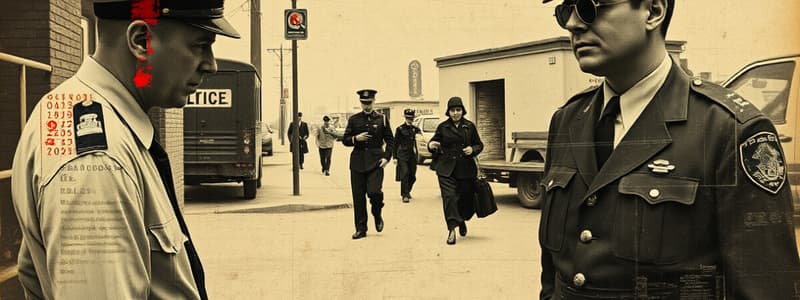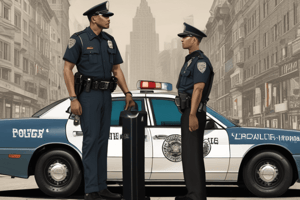Podcast
Questions and Answers
What should be done if there are multiple subjects of interest in a photo array?
What should be done if there are multiple subjects of interest in a photo array?
- Replace subjects with generic images to avoid confusion
- Present all subjects at once to expedite the process
- Include all subjects in a single photo array with fillers
- Use different fillers in separate photo arrays for each subject (correct)
What is a key requirement for the layout of photos in the array?
What is a key requirement for the layout of photos in the array?
- Photos must have a similar layout and general appearance (correct)
- Photos should be in random order to prevent bias
- All photos should contain identifying marks for clarity
- Photos should be in color and cover the entire page
Who should present the photo array to the victim/witness?
Who should present the photo array to the victim/witness?
- Any officer in the department irrespective of knowledge
- A colleague who knows the subject of interest
- An officer who has a relationship with the victim/witness
- A member unaware of the subject of interest (correct)
What must a victim/witness do before viewing the photo array?
What must a victim/witness do before viewing the photo array?
Which statement is NOT part of the instructions given to the victim/witness?
Which statement is NOT part of the instructions given to the victim/witness?
How should identifying information on photos be handled?
How should identifying information on photos be handled?
What is the purpose of the blind administration of the photo array?
What is the purpose of the blind administration of the photo array?
What is required for the photos used in the array?
What is required for the photos used in the array?
What is the primary purpose of establishing guidelines for eyewitness identification procedures?
What is the primary purpose of establishing guidelines for eyewitness identification procedures?
Which term describes a procedure where the officer does not know which photo the eyewitness is identifying?
Which term describes a procedure where the officer does not know which photo the eyewitness is identifying?
What does 'Filler' refer to in the context of eyewitness identification?
What does 'Filler' refer to in the context of eyewitness identification?
What is a Field Show-up?
What is a Field Show-up?
Which of the following best defines 'Photo Array'?
Which of the following best defines 'Photo Array'?
In which situation are the procedural guidelines on eyewitness identification mainly applicable?
In which situation are the procedural guidelines on eyewitness identification mainly applicable?
What does the term 'Subject of Interest' refer to?
What does the term 'Subject of Interest' refer to?
Which statement regarding eyewitness identification procedures is incorrect?
Which statement regarding eyewitness identification procedures is incorrect?
What action must be taken if a victim or witness does not positively identify a subject of interest?
What action must be taken if a victim or witness does not positively identify a subject of interest?
Under what condition will a field show-up be considered acceptable?
Under what condition will a field show-up be considered acceptable?
Which of the following scenarios is NOT allowed in the field show-up procedure?
Which of the following scenarios is NOT allowed in the field show-up procedure?
What is required for non-investigative members to utilize field show-up identification?
What is required for non-investigative members to utilize field show-up identification?
Which statement regarding the use of photo arrays is accurate?
Which statement regarding the use of photo arrays is accurate?
What must members avoid in order to ensure a non-suggestive identification procedure?
What must members avoid in order to ensure a non-suggestive identification procedure?
What characteristic is NOT recommended for fillers in a photo array?
What characteristic is NOT recommended for fillers in a photo array?
What is the procedure when clothing articles from a crime scene are found?
What is the procedure when clothing articles from a crime scene are found?
What is a critical component of conducting a field show-up?
What is a critical component of conducting a field show-up?
Who can present photo arrays according to the directive?
Who can present photo arrays according to the directive?
What factor is NOT considered when selecting fillers for a photo array?
What factor is NOT considered when selecting fillers for a photo array?
What is prohibited when interacting with a victim/witness during identification?
What is prohibited when interacting with a victim/witness during identification?
What should be done with the identity of the subject of interest after a field show-up?
What should be done with the identity of the subject of interest after a field show-up?
What approach does the Department use when conducting eyewitness identification?
What approach does the Department use when conducting eyewitness identification?
Why should a filler not be used if the administrator knows the filler?
Why should a filler not be used if the administrator knows the filler?
Which level of approval is required for the use of artist sketches?
Which level of approval is required for the use of artist sketches?
What factor is least likely to be considered when deciding if a field show-up identification should take place?
What factor is least likely to be considered when deciding if a field show-up identification should take place?
What is the maximum time period allowed after a victim's/witness's observation to conduct a field show-up?
What is the maximum time period allowed after a victim's/witness's observation to conduct a field show-up?
Which of the following statements about conducting field show-ups is correct?
Which of the following statements about conducting field show-ups is correct?
When should a field show-up identification not be conducted?
When should a field show-up identification not be conducted?
What is an appropriate reason for detaining a subject of interest for a field show-up?
What is an appropriate reason for detaining a subject of interest for a field show-up?
Which identifier would be considered as a key identifier during a field show-up identification?
Which identifier would be considered as a key identifier during a field show-up identification?
What is the main purpose of documenting factors before a field show-up?
What is the main purpose of documenting factors before a field show-up?
What kind of identification method should be avoided unless in an emergency during a field show-up?
What kind of identification method should be avoided unless in an emergency during a field show-up?
Flashcards are hidden until you start studying
Study Notes
Eyewitness Identification Procedures
- Aimed at protecting innocent individuals from misidentification while aiding in identifying suspects.
- Guidelines specifically cover photo arrays and field show-ups.
Key Terminology
- Blind Administration: Administrator does not know the suspect’s identity during the photo array process.
- Field Show-up: Live presentation of a suspect to a witness shortly after a crime.
- Filler: Person or photo included in identification who is not the subject of interest.
- Photo Array: Collection of photographs presented to a witness for identification.
- Subject of Interest: Person suspected of involvement in a crime.
Department Policies
- No reliance on facial composites; artist sketches need division commander approval.
- Non-investigative members may use single identification photos if the suspect is known to the witness.
- Photo arrays only presented by members assigned to investigative units.
Photo Arrays
- Utilize a sequential presentation approach for eyewitness identification.
- Require a minimum of five fillers, similar in appearance to the subject of interest (gender, race, age).
- Fillers should not be familiar to the witness.
- Only one subject of interest per photo array, with separate arrays for multiple subjects if needed.
- Photos should be uniform in layout, devoid of identifying marks.
- Presentations must be conducted blind; administrators must not know who the subject of interest is.
Instructions for Witnesses
- Witnesses must understand and sign acknowledgment of instructions before viewing the array, emphasizing their independent judgment.
- Photos are handled as evidence, regardless of identification outcome.
Field Show-ups
- Considered inherently suggestive; officers must weigh specific factors such as viewing time and proximity to the crime before proceeding.
- Should not take place if sufficient probable cause for an arrest exists without a witness identification.
- Lawful to detain suspects fitting descriptions based on reasonable suspicion.
- Must occur within one hour of the witness's observation and should ideally be live, not through photo comparison.
- Emergency situations allow for rapid field show-ups, requiring a non-suggestive process.
- Factors like handcuff visibility and location (not in police vehicles or cells) are crucial for fairness.
- If no identification is made, suspects must be released unless further evidence develops.
Conducting Show-ups
- Subjects should not be returned to crime scenes to avoid contamination.
- Witness transportation must maintain non-suggestive conditions to prevent bias.
- Identification procedures must be managed to avoid implying suspect guilt to witnesses.
Studying That Suits You
Use AI to generate personalized quizzes and flashcards to suit your learning preferences.





